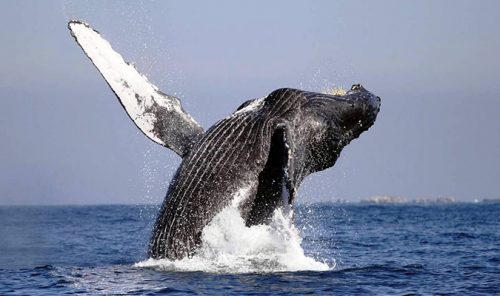Gray whales (Eschrichtius robustus) are the most primitive of the baleen whales. They are twice the size of orcas. Biologists however believe that gray whales get along peacefully with many other marine species. They are not named after their body color because they are not gray—not at least at birth.
Gray Whale Facts
Anatomy
- Unlike most other baleen whales, gray whales seem to have a series of 8 to 14 bumps on their back. The series forms a ‘dorsal ridge’.
- The length of the short baleen plates measures around 20 inches (50 cm). These plates are arranged in two groups of 130 – 150 plates, and they are ivory to yellow in color. The plates are quite thick in comparison to other baleen whales.
- Gray whales are half the size of a blue whale and as such they are considered medium-sized whale species. The adult female averages 46 ft (14 m) in length and weighs up to 70,000 lb (32,000 kg). Males are slightly smaller with the length reaching 43 ft (13 m).
- The tail flukes measure 9 feet across and weighs up to 400 pounds.

Distribution
- Gray whales once occupied the North Atlantic and North Pacific basins but the Atlantic populations became extinct by 1700s. The primary reason was whaling.
- The whales living in the eastern Atlantic are known to spend much of their summer in Baltic Sea while in winter they migrate towards the Mediterranean and Atlantic coasts of southern Europe.
- Like the eastern Atlantic population, the western Atlantic population also swims across the Baltic Sea but they migrate towards the eastern coast of North America for breeding. Here the females will bear their young in bays and shallow lagoons off southeastern Florida.
- Gray whales belong to the eastern Atlantic move towards the Bering, Beaufort, and Chukchi Seas for feeding.
- The gray whales’ migration begins in October and ends in January. By the end of January one can find the largest concentration of gray whales at calving grounds along the eastern side of the Gulf of California and the west coast of Baja California.
Habitat
- Gray whales are primarily known for their migration and feeding in shallow waters. They will find their breeding habitats close to the shore typically within 1.9 to 3.1 mi (3–5 km) of land.
- The whale is also called ‘the desert whale’ for a simple reason that it goes after the shallow desert lagoons—a behavior unique to gray whale. It doesn’t breed in open sea.
- During winter, the coasts of the Baja California: Guerrero Negro Lagoon, Scammon’s Lagoon, San Ignacio Lagoon, and Magdalena Bay become their breeding habitats.
Behavior
- Gray whales make the longest migration of any mammal. The eastern Pacific whales travel as far as 10,000–12,000 mi (16,000– 19,300 km). The traveling continues all year-round. Unlike blue whales and humpback whales, the gray whales swim across the coastal waters.
- They travel day and night and each day grays cover a distance as much as 125 kilometers. By late November, while traveling south for the winter, grays passes through the Unimak Pass, in the Aleutian Islands off the southwest part of Alaska. Here the grays go 0.5 km (1,700 ft) offshore. The water is less than 65 feet deep.
- The whales swim at a speed of 4.4–5.6 mph (7–9 km/h), but are able to attain 8 mph (13 km/h).
- Gray whale’s ‘blow’ hardly rises ten feet above the water surface however the blow of a blue whale goes way too high.
- The dive lasts for 4 – 5 minutes and their deepest dive ever recorded is at a depth of 248 ft (75.6 m).
- The migrating whales do not travel in groups except when mothers are with their young. Groups consist of 8 – 10 animals. The female whales with their calves tend to go farther than those traveling alone. While traveling northward, they will continue their journey as they pass through Bering Sea until they make it to the Chukchi Sea. At Chukchi Sea she might not find abundant food but the reason why she stops here is that predators like killer whales could not reach this place. Many whales however gather around the Bering Sea for feeding.
- Gray whales are sharp enough to detect their enemies (orcas) by their vocalizations. At times, they do change their course of traveling to hide into the beds of kelp.
- They are also known to display a ‘breaching’ behavior—a behavior in which it leaps above the water surface and falls on its back. Gray whales are also involved in ‘spy-hopping’ in which it raises its head (outside the water) while keeping the body in a vertical position.
- Gray whales never make complex vocalizations. Their voices have a frequency of less than 1500 Hz. Their voices are like clangs, pops, and croaks.
Feeding Diet and Ecology
- Gray whales catch their prey from sea floor. The whale dives down and rolls to the right side and eat take in a mouthful of soft sediment and water. The gray whale’s tongue is the size of a compact car which it uses to push the muddy mouthful forward against its baleen.
- They consume amphipods and are likely to eat small crustaceans and shrimp which they can easily find in burrows on the ocean floor.
- Gray whales migrate towards the northern Pacific Coast during summer where they are able to feed on amphipods. Prominent among the amphipods is Ampelisca macrocephala which makes up 95% of the whale’s diet.
- They will also consume other small bottom-dwelling invertebrates such as marine worms, crabs, and clams. Gray whale population in the Clayquot Sound, British Columbia is most likely to eat mysid shrimp, pelagic porcelain crab larvae, and benthic ghost shrimp.
- Most of the feeding occurs in between May and November. They spend these months in the freezing Arctic waters.
- Each year the adult gray whale consumes as much as 65 tons (59 tonnes). However during migration they will eat very little. The pregnant whales are going to store calories enough to make long-distance southward migration in summer.
Reproductive Biology
- Gray whales seem to use quite different habitats—one for mating—the other one for calving. They are likely to mate during migration but courtship or mating can occur when they’re about to reach their breeding place, lagoons.
- Although gray whales are not really social they are nevertheless very active during courtship—often found in breaching or swimming in line.
- They become mature at the age of 6 – 8 years but females typically give their first birth in the ninth year.
- The gestation period lasts for about 13.5 months while the breeding cycle averages 2 years. The pregnant females leave the breeding lagoons in mid-February.
- The birth occurs in the Baja lagoons between early January and February. A calf is 15 ft (4.6 m) long at birth and weighs up to 1,100 lb (500 kg). After birth the calf will drink 50 gallons of milk (190 l) each day. The whale’s milk contains 6 times the protein of human milk. Many calves will probably reach the length of 18–19 ft (5.5–6 m) by the end of winter. The calves often spend their time surfing on the waves or spinning very quickly in one spot up to 60 rpm.
- The mothers spend a great deal of time with their calves so that when they are gone, the calves must get through on their own. Now these calves have learnt to run off their predators.
- Gray whales rear their young for 6 – 7 months.
- The gray whales are able to live up to 70 years max.
Conservation Status
Least Concern
References
Dedina, Serge. Saving the Gray Whale: People, Politics, and Conservation in Baja California. Tucson: University of Arizona Press, 2000.
Gray Whales (Eschrictius robustus): Eastern North Pacific Stock. National Marine Fisheries Service. December 10, 2000. <http://www.nmfs.noaa.gov.prot_res/PR2/Stock_Assessment _Program/Cetaceans/Gray_Whale_(Eastern_N._Pacific)/AK 00gray whale_E.N.Pacific.pdf>.
Buckland, S. T., and J. M. Breiwick. “Estimated Trends of Eastern Pacific Gray Whales from Shore Counts (1967/68 to 1995/96).” Journal of Cetacean Research and Management 4, no. 1 (2002): 41–48.

Leave a Reply